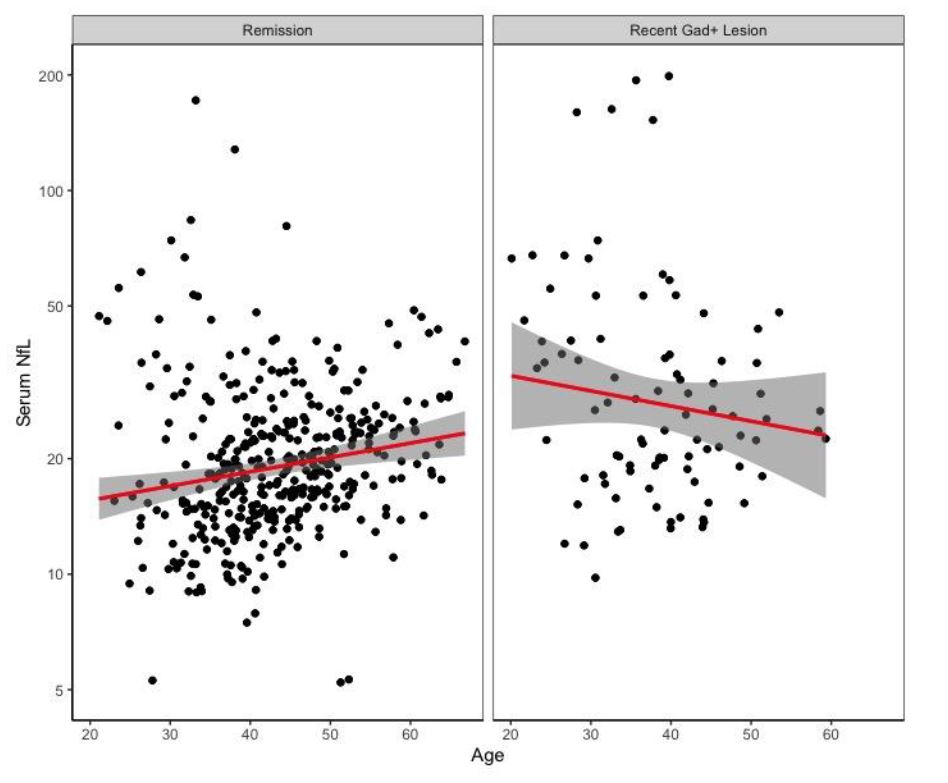Multiple Sclerosis
Differential Association of Age and Serum Neurofilament Light Chain in MS Patients



Posted May 27, 2020
Tanuja Chitnis, M.D., Brigham and Women's Hospital

Multiple sclerosis (MS) is a chronic demyelinating inflammatory disorder of the central nervous system. Patients experience periodic relapses and varying ranges of disability accrual over their lifetime. While no predictors of relapses are currently available in clinical settings, a variety of molecules, including the serum neurofilament light chain (sNfL), have shown promise as potential biomarkers. sNFL was shown to correlate with relapses in MS; however, there was high variability from patient to patient, which was partly attributed to the effects of age and relapse status.
With funding from a Multiple Sclerosis Research Program (MSRP) Fiscal Year 2017 Investigator-Initiated Research Award, Dr. Chitnis and her team aimed to evaluate biomarkers that will identify MS patients at high risk for relapses or worsening disability and radiological outcomes. The team is using clinical and MRI data and biosamples from the Comprehensive Longitudinal Investigations in MS at the Comprehensive Longitudinal Investigation of Multiple Sclerosis at BWH (CLIMB) Study, a large cohort of over 2,100 MS patients that were followed over 10 years and includes patients with relapsing as well as remitting disease.
First, Dr. Chitnis and her team focused their efforts on the promising potential biomarker sNFL, comparing serum from patients in remission and from those that had a newly detected lesion (gadolinium-enhancing [Gd+]) using MRI. They showed that the sNFL is elevated within a 3-month window of new Gd+ MRI lesions, which informs the frequency at which this biomarker may be surveyed in the clinical setting.

Ann Romney Center for Neurologic Diseases
Brigham and Women's Hospital, Harvard Medical School
They also studied the correlation between sNfL and age in patients in remission, immediately after a clinical relapse, and immediately after a Gd+ lesion. They measured the sNfL levels annually for 10 years with a single-molecule array assay. They showed that, during remission, patients had a 1.18% annual increase in sNfL levels with increasing age. Specifically, the eldest group (fourth age quartile) showed 31.2% greater sNfL levels than the youngest group (first age quartile). In the 3 months following a clinical relapse, sNfL showed a 2.2% annual increase with increasing age; however, sNfL was not significantly associated with age during the 3 months after a Gd+ lesion. When comparing the association between sNfL and age after a Gd+ lesion to a paired remission sNfL sample, they observed a negative (-1.72%) interaction between age and Gd+ lesion status. They also found that, at a relapse or Gd+ lesion, sNFL decreases with increasing age, with the opposite occurring in remission samples. Overall, these findings show a direct correlation of sNfL levels with age during remission, whereas this relationship is inversed when sNFL is measured at or after a Gd+ lesion.
These results support sNfL as an indicator of clinical and radiological activity in MS that shows promise as a noninvasive biomarker of disease activity. Furthermore, combining serum sNfL levels with radiological activity would allow clinicians to identify patients at higher risk of severe outcomes and enable earlier interventions than previously possible. These capabilities may also support predictive models for treatment response and short- and long-term disease outcomes, ultimately helping identify new ways of treating MS.

Link
Last updated Friday, December 13, 2024














